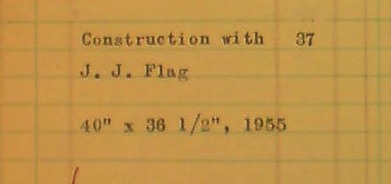
tiny detail of a Robert Rauschenberg registry, dated 1957-9, which I can't reproduce in full because of the terms of access to the Leo Castelli Gallery Archive at the Archives of American Art
Another day back in the Leo Castelli Gallery papers at the Smithsonian's Archives of American Art, and barely further along in my project to piece together the surprisingly complex history of Robert Rauschenberg's Short Circuit.
After finding Castelli's insurance claim for the "loss" of the Jasper Johns flag painting which was originally included in Short Circuit--a claim which makes absolutely no mention of Short Circuit itself or Rauschenberg--and reading Michael Crichton's first published account of what happened, I wanted to see if there was any record of Short Circuit entering Castelli's collection.
There was not.
The folks at the AAA who'd processed Castelli's archive had already warned me that there was remarkably little personal material, and little relating to Castelli's own collection. Nevertheless, there were plenty of traces of Leo's own holdings scattered throughout the files; when Rauschenberg's Bed was discussed, for example, Castelli's ownership of it was at least mentioned.
What I came to see, though, is that especially when compared with other combine paintings from the 1950s, or, other works in Castelli's and Rauschenberg's collections, Short Circuit was almost completely absent from the ever-increasing stream of notes, discussion, and paperwork related to the artist's career.
It'd be weird to lay out all the places that Short Circuit wasn't, but I'll give two examples: until the 1965 insurance claim, it never showed up in the photo reproduction orders the gallery sent to Rudy Burckhardt, who apparently shot all Rauschenberg's [and other Castelli artists'] work at the time. In early 1967, when the gallery was negotiating with the British writer Andrew Forge to publish Rauschenberg's first monograph, Short Circuit was not included in any otherwise comprehensive-seeming works lists or photo lists he received.

I have to think this negation-by-withdrawal is linked to Rauschenberg's breakup with Johns, and to what Johns referred to in 1962 as the "solution of differences of opinion between him and me over commercial and aesthetic values relating to that work." So long as had Johns' flag painting in it, Rauschenberg was to keep the work out of public circulation.
In fact, the only archive mention of Short Circuit at all before Rauschenberg's 1976 Walter Hopps retrospective, is in an early artist's registry. The looseleaf, ledger paper list is dated 1957-59, when Rauschenberg and Johns were together and both having groundbreaking first solo shows at Castelli [in 1958, Johns in January, and Rauschenberg in March].
And technically, it wasn't even Short Circuit; it was listed as "Construction with J.J. Flag," with the dimensions and date, "40 x 36 1/2, 1955."
There's alo a handwritten notation that the work had been exhibited at Cornell University in the spring of 1958. That would be the second showing Johns had referred to in 1962. [The first, the 1955 Stable Gallery show for which it was created, is not mentioned.] The idea that Short Circuit--a work which merged the two artists' signature innovations--was exhibited immediately after their controversial, back-to-back, solo shows would seem like big news. But no. Paul Schimmel's 2005 Combines catalogue only lists the "group exhibition" in a footnote, and I haven't found any other reference to the show online. In 1958, the director of the Cornell Museum would have been the critic/professor Alan Solomon, who was tight with all those Poppy guys. [He'd go on to curate definitional Pop Art shows in 1962.] I've contacted Cornell; we'll see if they have anything on the show.
If there was a "difference of opinion" about publicly displaying Short Circuit, I think we can assume that Johns did not want it shown, and Rauschenberg did. Because soon after the flag painting was removed, Rauschenberg put the combine into Elayne Varian's traveling collage exhibition at Finch College Museum--with the doors nailed shut.
It's funny, all this time I've been poking around this piece, I've thought of it in terms of "getting the Johns back." But when you think about it, the one who got his work back in this caper is Rauschenberg.
UPDATE: Whoa, I just noticed that the dimension mentioned above--40 x 36 1/2"--don't match up at all with those given in Hopps's 1976 catalogue: 49 3/4 x 46 1/2. What up? Is "Construction with J.J. Flag" NOT Short Circuit after all? It is an error, another missing flag/combine combo, or an upending of the original Stable Gallery story? If the Johns flag is 17" or so, there is no way that piece above is 50", or even 46". Gagosian lists the dimensions as 40 3/4 x 37 1/2", which is close enough for me. No sweat, Hopps & co just had bad info.












